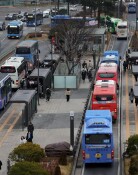Firms race to introduce power saving system
Firms race to introduce power saving system
Posted August. 10, 2013 04:44,
A smart power saving campaign using information technology is drawing growing attention from companies amid rising concern over power shortages in the wake of scorching weather following the monsoon season. Not only large production plants but also retail stores are rolling up their sleeves in the drive to save energy.
This reporter visited Yonsei University branch of GS 25 convenience store chain in Changcheon-dong in Seouls Seodaemun district on Thursday, when the ready alert, the lowest of the five-level power supply alert system was put in place for the first time this month. A 10-inch monitor behind the check-out counter displayed the previous months power consumption, this months projected consumption, and power consumption per minute. The touch screen also featured the functions to control the freezers, air-conditioners and lights, and thus allows the operator to adjust air-conditioning and lighting levels during hours of slow business.
The equipment was developed by LG Electronics and installed at the store for test operation. LG Electronics changed all the lights at the convenience store with highly energy-efficient LED lights. It also combined outdoor fans for the freezers with those for air-conditioners, and thus allowed the recycling of waste heat from the freezer for heating the store in the winter.
Through the process, the store transformed into an energy-saving shop. The 73-sq. meter store saw its electricity consumption decline by 29 percent from the previous year, which led to a saving of over 3.3 million won (3,000 dollars) in 2011 when it introduced the system. The stores power consumption in 2012 came at a level similar to that in 2011.
With the effect of its power saving demonstrated, GS Retail, which runs GS25 convenience stores, has been increasing the number of its stores adopting the technology since last year. The company plans to install the new system at 250 stores nationwide by the end of this month.
A company source said, These stores require extra 5 million won in initial investment than common conventional stores, but it is good technology that allows us to redeem the investment instantly and reduce energy consumption. As such, we will expand introduction of the system starting with stores that require replacement of aged facilities.
A growing number of companies are introducing the building energy management system, which uses IT technology, as is the case for GS Retail. Though only large buildings used such technology in the past, it is now spreading to convenience stores and large retail stores.
The discounter Tesco Homeplus changed lights to LED lighting at underground parking lots at its Gayang and Gangseo branches in Seoul last year, and introduced a system that adjust the level of lighting using sensors. Due to the system, Homeplus, which has cut power consumption for lighting at its parking lots by 79 percent, is expanding the introduction of the system to 60 stores this year.
Early this year, Shinsegae Department Stores main branch in Myeong-dong, Seoul requested Siemens to changed large motors for escalators and ventilation systems at parking lots into high-efficiency inverter motors, and replaced lights over escalators with LED lighting. Through these efforts, the department store expects to save 120 million won (108,000 U.S. dollars) in electricity utility cost per year.
With more companies joining the campaign to save energy, the building energy management system industry (BEMS) is also growing robustly. According to Pike Research, a market survey company, the BEMS market is growing 14 percent on average per annum, and is expected to hit 6 billion dollars in 2020.







